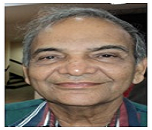Day 2 :
Keynote Forum
Wassil Nowicky
Nowicky Pharma/Ukrainian Anti-Cancer Institute, Austria
Keynote: The selective effect of NSC-631570 on women reproductive cancers
Time : 10:00-10:35

Biography:
Wassil Nowicky is the Director of Nowicky Pharma and President of the Ukrainian Anti-Cancer Institute, Vienna, Austria. He has completed his Graduation to Diplom-Ingenieur at the Radio technical Faculty of the Technical University of Lviv, Ukraine. He is the inventor of the anticancer preparation on the basis of celandine alkaloids “NSC-631570”. He is the author of over 300 scientific articles dedicated to cancer research. He is a real member of the New York Academy of Sciences, member of the European Union for Applied Immunology and of the American Association for Scientific Progress, Honorary Doctor of the Yanka Kupala University in Hrodno, and Doctor “honoris causa” of the Open International University on Complex Medicine in Colombo.
Abstract:
First indications on the selective effect of NSC-631570 on the cancer cells were provided in an early study when different oxygen consumption by normal liver cells and Ehrlich’s tumor ascetic cells after the incubation with NSC-631570 was revealed. In the tests on the Jurkat lymphoma model, NSC-631570 has been proven to be a strong apoptosis inductor. Profound research showed NSC-631570 brought about the depolarization of mitochondrial membranes and consequently the activation of caspases. NSC-631570 induced apoptosis in a panel of cancer cell lines (ovarian and cervical cancer HeLa, HeKB, HeKS32, HeBcl3, HeNFR and HeIKK, human colon cancer SW480, human renal carcinoma HEK293, human osteosarcoma MG-63) by activating the caspases of the intrinsic cell death pathway. Interestingly, non-transformed fibroblasts (hTERT) cell line was insensitive to the drug. In the tests on human ovarian and cervix carcinoma cells HeLa, squamous carcinoma cells WHCO5, normal kidney cell line Graham 293, and transformed kidney cell line Vero from African green monkey, NSC-631570 inhibited the tubulin polymerization and caused a metaphase block in cancer cells which is characterized by abnormal chromosomal distribution, and results in the formation of micronuclei and in apoptosis
Keynote Forum
Michael J Sinosich
Douglass Hanly Moir Pathology, Australia
Keynote: What does first trimester biochemistry tell us?
Time : 10:35-11:10

Biography:
Michael J Sinosich has completed his PhD on Trophoblast Physiology and PAPP-A. His research interests include non-invasive assessment of fetomaternal wellbeing. He is the Director of Prenatal Testing (DHM Pathology) and serves as Consultant at Pictor Ltd, a developer and manufacturer of multiplexed microELISA assay platform. He has published and presented numerous papers in reputed journals and holds several patents.
Abstract:
Prenatal screening for assessment of fetal development has been established for almost half a century. Here is a review of our first trimester screening programme. Study group included: i) aneuploid: trisomy 21 (n=128), trisomy 18 (n=52), trisomy 13 (n=14), triploid (n=31), sex chromosome aneuploidies (n=24) ii) failed pregnancies (n=380), iii) fetal structure: anencephaly (n=12), fetal growth restriction (n=11), iv) maternal health: gestational trophoblastic disease (n=13), sub-chorionic bleeding (n=21). PAPP-A, FbhCG and AFP were quantified (DELFIA® DXpress; PerkinElmer) and marker MoM values calculated by LifeCycle v2.2 (Perkin Elmer), using lot specific derived polynomial regression curves. In table median MoM values are presented for three fetoplacental derived markers. A low PAPP-A was associated with poor pregnancy prognosis, including fetal mal development. FbhCG levels were increased in pregnancies carrying Trisomy 21 fetus (2.01+/-0.28), and pregnancies with coexistent trophoblastic disease (21.94+/-66.95. AFP levels were increased in pregnancies which experienced transplacental bleeding (4.06+/-2.79) or pregnancies carrying an anencephalic fetus (1.70+/-0.41). All markers were significantly increased in pregnancies carrying multiple foetuses but not in pregnancies with a demised twin. The above findings confirm: i) low PAPP-A level is the cause for concern requiring assessment of fetoplacental wellbeing, ii) elevated FbhCG level warrants examination of fetal and trophoblast development, and, iii) elevated AFP levels may be due to “leakage” of fetal blood into maternal circulation or to fetal structural maldevelopment, such as, anencephaly.
Keynote Forum
Robert J I Leke
Catholic University of Cameroon, Cameroon
Keynote: Reducing maternal mortality through the prevention of unsafe abortion and their complication in Cameroon
Time : 11:30-12:05

Biography:
Robert J I Leke is an Emeritus Professor of Gynaecology and Obstetrics. He has 40 years of experience in teaching and practicing gynaecology/obstetrics in universities. He has completed his Graduation with specialised certificate in gynaecology and obstetrics at the University of Montreal in 1978 and also earned a Fellow of the Royal College of Canada, the same year. He has been teaching gynaecology and obstetrics since 1978. He has been Professor and Head of Gynaecology and Obstetrics at the University of Yde 1; Dean of the School of Health Sciences at University of Montagne in Bagante. Currently, he is a Provost in the School of Health and Medical Sciences at the Catholic University of Bamenda in Kumbo.
Abstract:
Cameroon is a country in central Africa with a population of 22 million inhabitants of which 51% are women. Maternal mortality in Cameroon has not followed the expected reduction as elsewhere but on the contrary it has registered an increase passing from 454/100 000 LB in 1991 to 782/100 000 live births in 2011. There has not been any significant reduction in the last years. WHO estimated in 1994 that there were 20 million unsafe abortions in the world per year with about 70,000 maternal deaths from these abortions and their complications. WHO also estimated that 50% of pregnancies resulting in abortion were unwanted hence the high number of unsafe abortions. We have estimated that in the central maternity in Yaounde (Cameroon) about 30% of maternal deaths are due to complications of abortions. In Cameroon the unmet needs for family planning are 22%. The major complications of induced abortions include haemorrhage, perforations, septicemia and intestinal trauma. Long term complications of unsafe abortion include: chronic pelvic pain, tubal obstruction, secondary infertility, ectopic pregnancies and fistulas. The major direct abstetrical causes of maternal deaths in Cameroon are: haemorrhage (24%), infections (15%), complication of abortion (about 30%), preeclampsia-eclampsia (12%) and obstructed labours (8%). The major causes of abortions in Cameroon being: lack of risk, lack of sexual education, lack of family planning, precious marriages restrictive abortion laws, insufficient trained personnel. The real incidence of induced abortions is difficult to estimate in a country with limited legal access to abortions as in Cameroon. Abortions, where they are allowed by law, can be done by medical methods (misoprostol) or by surgical methods of management like uterine aspirations (MVA). In countries where access to abortion is low, unsafe abortions by untrained persons working in inappropriate milieu result to high complications from induced abortions. This is the case of most African countries south of the Sahara and explains the high maternal mortality due to complications of induced abortions in these countries. Interventions to avoid abortion related maternal deaths would include proper management of abortion complications, increased use of family planning and post abortion FP with LARC, reduction of service costs in reproductive health services and modification of restrictive laws on abortion.
Keynote Forum
Vijay Nielsen
Nielsen Clinic, Canada
Keynote: Integrative endometriosis: New treatment alternatives
Time : 12:05-12:40

Biography:
Vijay Nielsen has completed his Diploma in Homeopathic Medicine at Dr. Nielsen’s Homeopathic Medical Education and Research Centre Inc. in Winnipeg, Canada; and fellowship at Vinayaka Mission's Hospital in Salem, India. In 2005, he opened Nielsen Clinic where he specializes in women’s health and dermatology, combining homeopathic medicine with a clinical approach. His clinic has won numerous awards and he was recently selected as one of the Impact Magazines Top Doctor for 2018. He has published his article in the Journal of Pharmacy & Pharmaceutical Sciences.
Abstract:
Endometriosis, a chronic inflammatory disease that affects the pelvic peritoneum and ovaries, is one of the most commonly diagnosed gynecological conditions in women. It represents a debilitating condition for females and a challenging and complex disease for clinicians. Endometriosis often is underdiagnosed and poorly treated, resulting in delayed diagnose, significant pelvic pain and infertility. Multiple studies have shown that endometriosis has a strong affinity towards estrogen, angiogenesis and dysregulation of the immune system. While conventional treatments are used, there is an unmet medical need to not only help improve treatment outcomes but provide treatment with a reduced risk of undesirable side effects. Fortunately, there are a wide variety of therapies available in nutritional and herbal supplements which may be used to treat endometriosis. Certain nutritional and herbal supplements have shown to exert complex actions on endometrial cells as well as regulate inflammation, angiogenesis and aromatase inhibitors. Additionally, nutritional and herbal supplements can safely be integrated with conventional treatments.
- Prenatal Diagnosis | Midwifery | Gynecological Oncology | Gynecology & Obstetrics
Location: Brussels

Chair
Wassil Nowicky
Nowicky Pharma/Ukrainian Anti-Cancer Institute, Austria
Session Introduction
Michael J Sinosich
Douglass Hanly Moir Pathology, Australia
Title: Development and application of nanotechnology based multiplexed microELISA system for remote antenatal populations

Biography:
Michael J Sinosich has completed his PhD on Trophoblast Physiology and PAPP-A. His research interests include non-invasive assessment of fetomaternal wellbeing. He is the Director of Prenatal Testing (DHM Pathology) and serves as Consultant at Pictor Ltd, a developer and manufacturer of multiplexed microELISA assay platform. He has published/presented numerous papers in reputed journals and holds several patents
Abstract:
Data is presented on a multiplexed microELISA platform which consists of a PictArray™, plastic slide of 16 microwells. Each microwell contains 25 defined specific immunoreaction immunoblots, consisting of assay controls and duplicate tests. Immunoblot intensity is determined by array reader, PictImager, and quantification performed by proprietary software (Pictorial©). This entire immunoanalysis solution is platform agnostic. Hence, due to its small footprint, superior affordability and simple technology, testing can be conducted in community health centres or outreach mobile health clinics. Current test menu includes screening for IgG and IgM for ToRCH and Hepatitis A & E antigens. Whereas, the ENA panel screen for IgG autoantibodies against nine connective tissue antigens. Testing may be performed on finger prick or with 10mL of serum. Due to simple technology, other region specific panels under development include sepsis and fever panels. Array precision profile compared favourably against established single analyte ELISA platforms and exceeded performance of many immunological Point-of-Care products. Direct comparison of Pictor Rubella IgG assay against commercial product, showed a significant correlation (r2) of 0.73. We have developed a versatile and robust multiplexed micro-ELISA test platform. Being platform agnostic and economical, the PictArray testing platform has been optimised for application to screen all populations, especially those rural communities which are currently beyond the reach of mainstream healthcare.
Pushpawati Thakur
All India Institute of Medical Sciences Raipur, India
Title: Effectiveness of awareness programme on knowledge, attitude and practices for early detection and prevention of cervical cancer in educated women

Biography:
Pushpawati Thakur has completed her Graduation with an MBBS in Obstetrics and Gynaecology and Post-graduation with an MS in Obstetrics and Gynaecology. Currently, she is working as an Associate Professor in the Department of Obstetrics and Gynaecology at AIIMS Raipur, India.
Abstract:
Introduction: Cervical cancer is the second most common cancer worldwide in women. In India, cervical cancer is the most common woman-related cancer. Every year about 500,000 new cases of cervical cancer are diagnosed worldwide and are responsible for about 280,000 deaths. India contributes to about 1/4th of the world’s registered cervical cancer cases. Around 90% of women in India are unscreened because of poor public awareness. The pap test is the most widely used screening test for cervical cancer worldwide. In United States, pap smear screening have significantly reduced the death related to cervical cancer. This is mainly because of the awareness of the women regarding cervical cancer and its screening tests.
Objective: To evaluate the effectiveness of structured awareness programme on knowledge, attitude and practices for early detection and prevention of cervical cancer among educated women.
Method: In this study, total 3500 participant were women studying in teaching institution in which structured information related to cervical cancer was provided and ask them to fill pre and post-test questionnaire related to knowledge KAP for early detection and prevention of cervical cancer.
Results: There was significant improvement in post test KAP score among the women after administration of structured awareness programme in relation to early detection and prevention of cervical cancer.
Conclusion: It shows there is need to spread awareness among the women in relation to early detection and prevention of cervical cancer
Parul Nigam
St. Jude’s Hospital, Jhansi, India
Title: Primary abdominal pregnancy with incisional hernia with previous two caesarean sections

Biography:
Parul Nigam is a Gynaecologist. She has completed her Post-graduate degree in Obstetrics and Gynaecology at King George Medical University, Lucknow, India. She has over 10 years of experience in this field. She has completed formal subspecialty training in Gynaecological Endoscopy; Diploma in Gynaecologic Ultrasound at reputed institute in Delhi. And one year certificate course in Diabetes. She is an Avid Reader and has done certificate course in genetics and genetics counselling. She is currently doing research work in the field of Infertility and Fetal Medicine. Her specialization is in the field of complete women health care solution. She is presently working as a Consultant in all the above disciplines in Nigam Hospital and St. Jude’s Hospital, Jhansi. She makes utmost effort to maintain global standards and provide the best possible treatment to her patients. She is a Member of IMA, FOGSI, and IAMG and has attended many national and international conferences.
Abstract:
Primary abdominal pregnancy is an extremely rare type of extra uterine pregnancy. It is potentially life threatening form of ectopic gestation with incidence of 1% of all ectopic pregnancies. Most of these pregnancies are terminated earlier due to spontaneous separation from the site of implantation and the patient may present with shock. So, a high index of suspicion is important for making a correct diagnosis especially with GI symptoms and its timely management. We report a case of primary abdominal pregnancy with incisional hernia in 35 years old-Gravida 3 Para 2 with previous 2 caesarean sections. She presented to us with severe abdominal distension and shock on account of herniation and obstruction of small bowel. She had severe nausea, vomiting and abdominal discomfort. She had not passed stools since last 2 days. She had been admitted earlier in a private nursing home for bleeding per vaginum. Dilatation and curettage was done without any antenatal ultrasound. Urine pregnancy test was positive. But her condition deteriorated after few hours and she was referred to a higher centre. Ultrasound was done which showed grossly dilated bowel loops and 15 weeks size foetus in the abdominal cavity. Emergency laparotomy was done obstructive incisional hernia was found due to previous caesarean section scar. Small bowel was entangled in the hernia sac. A live foetus of about 15 weeks was found trapped between the bowel loops. Placenta was attached to the omentum of the small bowel. Uterus was enlarged-about 10 weeks in size. Bilateral tubes and ovaries were normal. Contents of the hernial sac were reduced. Primary repair of hernia was done. Foetus was removed from the implantation site. There was no bleeding from the site. Patient was transfused 2 units of blood. Her post operative period was uneventful and she was discharged satisfactorily on day 7. Hence, ultrasound should always be done to rule out ectopic before termination of pregnancy. Midline vertical incisions are associated with increased incidence of ventral hernia. Complications of hernia like strangulation and ulceration of skin are to be avoided and managed during pregnancy.
Parul Nigam
St. Jude’s Hospital, Jhansi, India
Title: A classic case of couvelaire uterus: Case report

Biography:
Parul Nigam is a Gynecologist. She has completed her Postgraduation in Obstetrics and Gynecology at King George Medical University, Lucknow, India. She has over 10 years of experience in this field. She has completed formal subspecialty training in Gynecological Endoscopy; Diploma in Gynecologic Ultrasound at reputed institute in Delhi. And one year certificate course in Diabetes. She is an Avid Reader and has done certificate course in genetics and genetics counseling. She is currently doing research work in the field of Infertility and Fetal Medicine. Her specialization is in the field of complete women health care solution. She is presently working as a Consultant in all the above disciplines in Nigam Hospital and St. Jude’s Hospital, Jhansi. She makes utmost effort to maintain global standards and provide the best possible treatment to her patients. She is a Member of IMA, FOGSI, SELSI and IAMG and has attended many national and international conferences.
Abstract:
Couvelaire uterus also known as uteroplacental apoplexy is a very rare and life threatening condition in which premature separation of placenta causes bleeding that penetrates into the myometrium forcing its way into the peritoneal cavity. Its exact incidence is not known but is estimated to complicate about 5% of all cases of abruption. This paper reports a classic case of couvelaire uterus which we encountered some time back in our hospital. The patient was 24 yr. old primi at 35 weeks of pregnancy presenting at the middle of night with vaginal bleeding and loss of foetal movements. Her general condition was very low. She was severely anemic and hypertensive. Foetal heart sounds could not be traced. Patient was managed by an emergency caesarian section. The patient and her uterus could be saved but the baby was found dead and macerated. Placenta was already separated and retroplacental haemorrhage of about 1.5 liters was noted. This paper emphasizes the importance of antenatal screening and strict blood pressure monitoring in pregnancy. Nowadays new markers are available for early prediction of PIH and preeclampsia.
- Poster Presentations
Location: Europa Foyer
Session Introduction
Song-Nan Chow
National Taiwan University Hospital, Taiwan
Title: Anti-GnRH receptor monoclonal antibodies are long acting biosimilar GnRH antagonists

Biography:
Song-Nan Chow has completed his Graduation in the College of Medicine at National Taiwan University (NTU) in 1968 and, PhD in Graduate Institute of Clinical Medicine at National Taiwan University in 1983. He has completed an internship at Maimonides Medical Center, New York City, USA during 1972-1973. He was a Senior Investigator at University of British Columbia, Vancouver, Canada and Eastern Virginia Medical School, Norfolk, USA during March 1984 to August 1984. He served as Professor and Head in Department of Obstetrics & Gynecology, College of Medicine and the Hospital of NTU from 1999 to 2005. He was the Principal Investigator of International HPV-008 Cervical Cancer Vaccine Trial (PATRICIA) during 2004-2010 at National Taiwan University Hospital, Taipei, Taiwan. He got a patent of ovarian cancer biomarker from USA and Taiwan in early 21st century.
Abstract:
Monoclonal antibodies were generated against a synthetic peptide corresponding to N1-29 sequence located in the extracellular domain of human GnRH receptor. Among the fourteen established monoclonal antibodies GHR103 and GHR106 were shown to have the highest affinity (Kd≈2x10-9 M) to the synthetic peptide as well as to the native GnRH receptor in cancer cell extract as well as those from the anterior pituitary in humans. Through immunoglobulin gene analysis, both GHR103 and GHR106 were shown to have identical DNA sequences in both heavy and light chains of IgG1 subclass. GHR106 was shown to be highly specific to N1-29 peptides derived from GnRH receptor of human and money, but not to that from mouse. Immunohistochemical studies were performed with as many as 30 different cancer cell lines and were found to positively stain more than 80% of cases, irrespective of their tissue origins. Consistent results were obtained with other assays such as Western Blot, indirect immunofluorescence and RT-PCR. Similar to GnRH decapeptide antagonist, Antide, GHR106 was shown to induce apoptosis and inhibit cell proliferation to culturing cancer cells by TUNEL and MTT assays, respectively. Furthermore, GHR106 was shown to induce lysis of cancer cells in culture through complement-dependent cytotoxicity reactions (CDC) which are absent with GnRH peptide analogs. Humanized forms of GHR106 (hGHR106) were generated and found to be bioequivalent to murine GHR106 (mGHR106) as well as to GnRH antagonist, Antide in terms of their respective binding affinity and biological properties. Due to widespread expressions of GnRH receptor among various human cancer, hGHR106 can be bioequivalent alternative to GnRH decapeptide analogs and can serve as the antibody-based anti-cancer drugs of much longer half-life as compared to that of GnRH decapeptide analogs (days vs. hrs.). Furthermore, humanized GHR106 can be long-acting substitute to GnRH decapeptide analog for numerous gynecological indications in fertility regulations and women health.
Unya Plodpluang
Boromarajonani College of Nursing, Chakriraj, Thailand
Title: Experience of pregnancy prevention among adolescents in Thailand

Biography:
Unya Plodpluang has completed her Graduation and PhD in Research Measurement and Statistic Education at Burapha University, Thailand. She is a Deputy Director of Boromarajonani College of Nursing, Chakriraj, a college in Praboromarachanok Institute of Ministry of Public Health, Thailand. Her job description is research and knowledge management. In addition, she is a Nurse Instructor. She is interested in nursing and midwifery and has expertise about qualitative research. She has published more than 20 papers in proceedings and journals of nursing, education and public health. Currently, she is developing a model of health promoting for teenage pregnant girls by Family Support in Thailand. This model is collaboration of multidisciplinary, health volunteer, family member, midwifery, professional nurse and other professionals.
Abstract:
Teenage pregnancy is one of the major problems in the society. The outcomes of teenage pregnancy have been associated with risks such as obstetric complications, educational risks such as school dropout and socio-economic risks including reduced employment opportunities. In Thailand, the repeated pregnancy phenomenon is really serious. The purpose of this study was to gain an understanding of the experience of repeat pregnancy prevention among adolescents in Kanchanaburi. The key informants who volunteered to participants in this study consisted of 10 adolescents used to be a pregnant teenager and 5 nurses that care for pregnant teenagers. The purposive sampling was used for this study. The data collections and instruments used were a tape recorder, personal documents and in-depth interview. The method described by Hermeneutic phenomenology was employed to analyze the data. The major findings of the research were three categories as follow: Contraceptives temporarily that include the use of contraceptive pills is not regular and do not use condoms. Thai women using oral contraceptives take pills that are easily available at the pharmacy. However, it will not take contraceptive pills. Irregular but husbands do not usually use condoms; Acceptable of Family and; Prevent pregnancy repeat. After childbirth, pregnant women have repeated pregnancy prevention. There are two reasons why pregnancy is prevented because of the thought. Younger children should not have children. I want to go back to school. In order to find the next job. Adolescents have already had a repeat pregnancy and use contraceptive methods, including contraceptive implants. Contraceptive Injection and also have the choice of oral contraceptives. Pregnant women should be educated about the prevention of pregnancy, get the right type of contraceptives at each stage. And encourage families to take part in preventing pregnancy. This will improve the quality of life for adolescent pregnant women.
Ho Ping Ling
KK Women’s and Children’s Hospital, Singapore
Title: A rare case of uterine torsion in a postmenopausal woman

Biography:
Ho Ping Ling is a 6th year Obsterics and Gynecology Trainee at the KK Women's and Children's Hospital, Singapore. She is passionate about reproductive medicine and minimally invasive surgery. Her area of research interests includes pre-genetic diagnosis, sexual dysfunction and in vitro maturation/fertilization. She is looking to collaborate in research on the topic of pre-genetic diagnosis. Prior to joining KK Hospital, she has completed her Graduation at the National University of Malaysia (UKM) where she also completed her Doctor of Medicine.
Abstract:
We present a rare case of uterine torsion with myoma in postmenopausal lady in a tertiary centre, emphasizing the importance of high clinical suspicion and advanced radiological imaging in its management. A 52-year-old postmenopausal lady presented with abdominal pain and no bowel movements for 3 days. CT abdomen and pelvis showed uterine torsion whilst initial ultrasound pelvis was unremarkable. Patient underwent laparotomy total hysterectomy and bilateral salpingo-oophorectomy. Intra-operatively findings include torted, enlarged uterus with myoma. Post-operatively patient recovered well. Uterine torsion is an extremely uncommon cause of abdominal pain in women. However, it is a surgical emergency. Prompt identification and management are important to minimize associated morbidity and mortality. In this case, high clinical suspicion and advanced radiological imaging results in early identification and management.
- Maternal Fetal Medicine | Gynecological Oncology | Health-Related Behaviours In Women | Prenatal Diagnosis
Location: Brussels

Chair
P D Gupta
Manipal University, India
Session Introduction
Iin Fadhilah Utami
Hasanuddin University, Indonesia
Title: The analysis of caesarian section patients and their associated newborn conditions as an outlook of fetomaternal health in Indonesia

Biography:
Abstract:
Background: The mortality and morbidity rate of mothers and infants in Indonesia is still high. Caesarean section is done as a secondary indication for some complicated cases.
Aim: The aim of the study was to evaluate caesarian section patients and several influencing factors that associated with their newborn condition
Materials & Methods: As a cross-sectional study, we collected and evaluated samples who came and conducted caesarian sections with any indications at Fatimah Maternity Hospital in Makassar, Indonesia from January 1st to June 30th 2016. Samples were analyzed using SPSS.
Results: In this study, 119 patients who underwent caesarian section were evaluated. Indications of section caesarian were mostly due to CS history 30 (25.4%). The newborn condition were severe asphyxia 10(8.4%), moderate asphyxia 15 (12.6%) and 94 (79%) with normal conditions. There is no significant relationship existed between the newborn condition and indication of CS. Patients were referred mainly from primary health care (Primary Health Care, GP, etc) 99 (83.2%), Maternity hospital 7 (5.9%) and General hospital 13 (10.9%). Significant difference was found between newborn condition and patients refer (p<0.05). The level of mother’s education were varied from elementary school to undergraduates and there was significant difference in newborn condition and level of mother’s education (p<0.05). The level of newborn weight were classified with low birth weight 26 (21.8%) and normal birth weight 93 (78.2%). We also found the significant difference between the newborn condition and newborn weight (p<0.05).
Conclusion: The newborn condition of caesarian section was highly correlated with level of mother’s education, newborn weight, and patients refer. Therefore, these contributing factors can be used as recommendation to the government in improving the facilitation to decrease the mortality and morbidity of maternal and child as the way to improve fetomaternal health quality in Indonesia.
Pinar Sercekus Ak
Pamukkale University, Turkey
Title: Being a family caregiver of cancer patients: Autoethnographic study

Biography:
Pinar Sercekus Ak has completed his PhD at Dokuz Eylul University and Postdoctoral studies at Pamukkale University, Faculty of Health Sciences. She is an Associate Professor at Obstetrics and Gynecology Nursing Department. She has published more than 25 papers in journals. She wrote several textbook about obstetric nursing.
Abstract:
Autoethnography implies that researchers centre their studies on their own selves, their thoughts and feelings rather than focusing exclusively on others. Autoethnography author will present their own experiences rather than those of others. In this study, author will present this autoethnography study in which she will share her personal experience as relative of a patient whose father was diagnosed with esophageal cancer. Cancer is a difficult disease that affects patients and their families. The most important informal caregivers of cancer patients are family members. In the process of giving care, family members live in many physiological, psychological and social problems. Cancer is changing the daily lives of both patients and family members and increasing stress. Family caregivers suffer from headaches, insomnia, etc., depending on the stress they experience during the care process. In addition to caregivers suffer from headaches, insomnia, etc., depending on the stress they experience during the care process. Caregivers are experiencing shock, anxiety, weakness, irritability and fear of losing a loved one. Caregivers try to hide their feelings from the patient and avoid talking about the disease. Family members are not adequately supported by health personnel in this process. They expect to receive more information, be treated better and be given psychological support both on their own and in patients.
Nasrin Matinnia
Islamic Azad University, Iran
Title: Further evidence of psychological factors underlying choice of elective caesarean delivery (ECD) by primigravidae

Biography:
Nasrin Matinnia have completed her PhD at University Putra Malaysia in 2014 and continuied as an Assistant Professor in the Department of Nursing, College of Basic Science, Hamedan Branch, Islamic Azad University. She is the Director of Nursing group. She has published more than 19 papers in reputed journals and has been serving as a Reviewer in some journals.
Abstract:
Objective: Requests for elective caesarean delivery (ECD) have increased in Iran. While some sociodemographic and fear-related factors have been linked with this choice, psychological factors such as self-esteem, stress, and health beliefs are under-researched.
Methods: A total of 342 primigravidae (mean age=25 years) completed questionnaires covering psychological dimensions such as self-esteem, perceived stress, marital relationship quality, perceived social support, and relevant health-related beliefs.
Results: Of the sample, 214 (62.6%) chose to undergo ECD rather than vaginal delivery (VD). This choice was associated with lower self-esteem, greater perceived stress, belief in higher susceptibility to problematic birth and barriers to an easy birth, along with lower perceived severity of ECD, fewer perceived benefits from VD, lower self-efficacy and a lower feeling of preparedness. No differences were found for marital relationship quality or perceived social support.
Conclusion: The pattern suggests that various psychological factors such as self-esteem, self-efficacy and perceived stress, underpin the decision by primigravidae to have an ECD.
Nejla Gultekin
Mersin Sehir Hospital, Turkey
Title: The level of follistatin and activin in follicular fluid of long protocol in in vitro fertilization

Biography:
Nejla Gultekin is a Specialist in Obstetrics and Gynaecology at Mersin Sehir Hospital. She has completed her Education at Marmara University, Faculty of Medicine, in 2003 and worked at the Marmara University Hospital in Obstetrics and Gynaecology Department from 2004-2010. She worked in Pathology Department and Anaesthesiology Department at Maimonides Medical Center, New York-USA, in Obstetrics and Gynaecology Department and in Radiology Department at Weil Cornell Medical Collage, New York Presbyterian Hospital in New York-USA. Currently, she is working in the Obstetrics and Gynaecology Department at Mersin Sehir Hospital, Turkey.
Abstract:
Background & Objective: Do we estimate the success of the IVF treatment before the pregnancy test via intra follicular hormonal markers? The level of follistatin and activin is measured and their levels are compared with the oocyte grade in IVF patients.
Study Design: This study has 50 infertile patients. In our study, the best oocyte is taken from each woman. In the IVF treatment, the recombinant FSH doze around 200-300 IU. Human chorionic gonadotropin (HCG) 10.000 IU is administrated. The oocyte pick-up is started. The level of activin and follistatin are measured with ELISA testing. The advanced oocyte morphology grading system is used and the oocytes are divided into four groups.
Results: In this study, the worsening quality of oocyte by declining of level of follistatin and activin in the follicular fluid is demonstrated. In addition, the follistatin and activin level is decreased by rising of the age.
Conclusion: The systemic effects of gonadotropin will be more considerable reason than the fertility in the future. For this reason, we should find the available route of the local injection of gonadotropin to infertile patients. In that point, our study has an important role in the future.
- Video Presentation
Location: Brussels
Session Introduction
Radhouane Achour
Tunis-El Manar University, Tunisia
Title: Spontaneous acute intussusception in a pregnant woman: Clinical and therapeutic particularity

Biography:
Radhouane Achour is an Associate Professor at Faculty of Medicine of Tunis, Tunisia. He has published many basic and clinical articles in relation to gynecology and obstetrics. His research interests include “Rare diseases in gynecology and prenatal diagnosis”. He serves as an Associate Professor in Emergency Department of Gynecology and Obstetrics at Maternity and Neonatology Center Tunis; Faculty of Medicine of Tunis-El Manar University of Tunis-Tunisia. He also serves as Editorial Team Member of the Asian Pacific Journal of Reproduction, Global Journal of Rare Diseases, Journal of Neonatal Biology and member of The Science Advisory Board.
Abstract:
Acute intussusception in adults is rare and particularly so in pregnant women. Its incidence ranges from 0.067% to 0.0015%. The non-specific presenting symptoms may be attributed to the pregnancy itself, making the diagnosis difficult. When it happens, however, it causes considerable morbidity and mortality for the pregnant woman and the fetus. In adults, such intussusceptions are mainly secondary to an intestinal disease and frequently a tumor. We present the case of a 21-year old pregnant woman at nine weeks of gestation, gravida one para one, without medical history, was admitted with sudden start, permanent and paroxysmal pelvic pain two days prior to admission associated with rectorrhagia. She denied metrorrhagia, nausea, vomit, constipation or fever. The abdominopelvic ultrasound examination found an evolutive pregnancy at nine weeks of gestation with adnexal mass with ring of fire sign and a small amount of fluid in the cul-de-sac. An emergency surgery was performed by laparoscopy. Histology of the resected bowel segment ileocecal intussusceptions without evidence of malignancy. In summary, intussusception in pregnancy is a rare condition. The combined expertise of the obstetrician, radiologist, and surgeon are needed to manage the pregnant patient.








